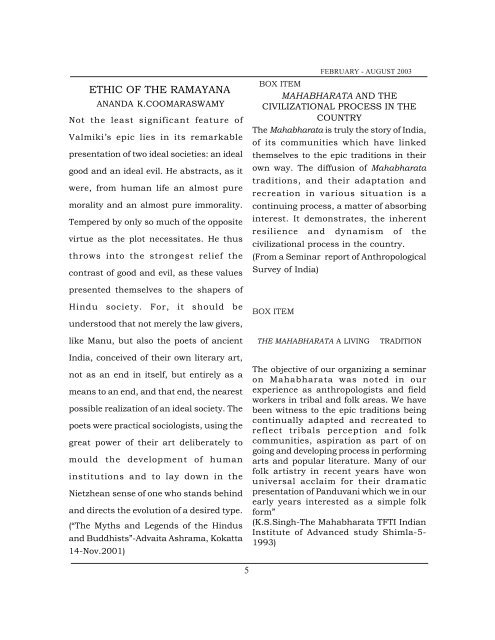Epics in Imprints-1.pdf - Vivekananda Kendra Prakashan
Epics in Imprints-1.pdf - Vivekananda Kendra Prakashan
Epics in Imprints-1.pdf - Vivekananda Kendra Prakashan
You also want an ePaper? Increase the reach of your titles
YUMPU automatically turns print PDFs into web optimized ePapers that Google loves.
ETHIC OF THE RAMAYANA<br />
ANANDA K.COOMARASWAMY<br />
Not the least significant feature of<br />
Valmiki’s epic lies <strong>in</strong> its remarkable<br />
presentation of two ideal societies: an ideal<br />
good and an ideal evil. He abstracts, as it<br />
were, from human life an almost pure<br />
morality and an almost pure immorality.<br />
Tempered by only so much of the opposite<br />
virtue as the plot necessitates. He thus<br />
throws <strong>in</strong>to the strongest relief the<br />
contrast of good and evil, as these values<br />
presented themselves to the shapers of<br />
H<strong>in</strong>du society. For, it should be<br />
understood that not merely the law givers,<br />
like Manu, but also the poets of ancient<br />
India, conceived of their own literary art,<br />
not as an end <strong>in</strong> itself, but entirely as a<br />
means to an end, and that end, the nearest<br />
possible realization of an ideal society. The<br />
poets were practical sociologists, us<strong>in</strong>g the<br />
great power of their art deliberately to<br />
mould the development of human<br />
<strong>in</strong>stitutions and to lay down <strong>in</strong> the<br />
Nietzhean sense of one who stands beh<strong>in</strong>d<br />
and directs the evolution of a desired type.<br />
(“The Myths and Legends of the H<strong>in</strong>dus<br />
and Buddhists”-Advaita Ashrama, Kokatta<br />
14-Nov.2001)<br />
5<br />
FEBRUARY - AUGUST 2003<br />
BOX ITEM<br />
MAHABHARATA AND THE<br />
CIVILIZATIONAL PROCESS IN THE<br />
COUNTRY<br />
The Mahabharata is truly the story of India,<br />
of its communities which have l<strong>in</strong>ked<br />
themselves to the epic traditions <strong>in</strong> their<br />
own way. The diffusion of Mahabharata<br />
traditions, and their adaptation and<br />
recreation <strong>in</strong> various situation is a<br />
cont<strong>in</strong>u<strong>in</strong>g process, a matter of absorb<strong>in</strong>g<br />
<strong>in</strong>terest. It demonstrates, the <strong>in</strong>herent<br />
resilience and dynamism of the<br />
civilizational process <strong>in</strong> the country.<br />
(From a Sem<strong>in</strong>ar report of Anthropological<br />
Survey of India)<br />
BOX ITEM<br />
THE MAHABHARATA A LIVING TRADITION<br />
The objective of our organiz<strong>in</strong>g a sem<strong>in</strong>ar<br />
on Mahabharata was noted <strong>in</strong> our<br />
experience as anthropologists and field<br />
workers <strong>in</strong> tribal and folk areas. We have<br />
been witness to the epic traditions be<strong>in</strong>g<br />
cont<strong>in</strong>ually adapted and recreated to<br />
reflect tribals perception and folk<br />
communities, aspiration as part of on<br />
go<strong>in</strong>g and develop<strong>in</strong>g process <strong>in</strong> perform<strong>in</strong>g<br />
arts and popular literature. Many of our<br />
folk artistry <strong>in</strong> recent years have won<br />
universal acclaim for their dramatic<br />
presentation of Panduvani which we <strong>in</strong> our<br />
early years <strong>in</strong>terested as a simple folk<br />
form”<br />
(K.S.S<strong>in</strong>gh-The Mahabharata TFTI Indian<br />
Institute of Advanced study Shimla-5-<br />
1993)

















